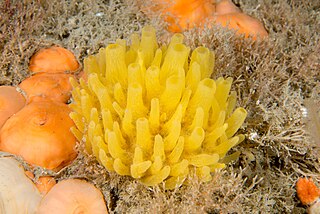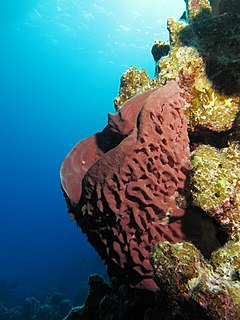
Polymastia is a genus of sea sponges containing about 30 species. These are small to large encrusting or dome-shaped sponges with a smooth surface having many teat-shaped projections (papillae). In areas of strong wave action, this genus does not grow the teat structures, but instead grows in a corrugated form.

Halichondriidae is a family of sea sponges belonging to the order Suberitida. These sponges have a skeleton consisting of dense bundles of spicules occurring in a more or less random pattern.

Agelas clathrodes, also known as the orange elephant ear sponge, is a species of sea sponge. It lives on reefs in the Caribbean, usually more than 10 metres (33 ft) below the surface of the ocean. It takes various forms, and its color is reddish orange.

Spongia is a genus of marine sponges in the family Spongiidae, originally described by Carl Linnaeus in 1759, containing more than 60 species. Some species, including Spongia officinalis, are used as cleaning tools, but have mostly been replaced in that use by synthetic or plant material.
Ircinia strobilina is a species of sponge in the family Irciniidae. It is grey or shiny black in colour, with spiny structures (conules) dotting the surface. The spiny structures are interconnected by ridges, though not arranged in an orderly lattice. This species is globular and massive in shape, but usually no more than 0.3 metres (1 ft) across. I. strobilina is lobed and spherical and has a tough consistency. The large excurrent pores are located in depressions at the top of the sponge. Many smaller incurrent pores are scattered across the surface, more densely at the sides.

Haplosclerida is an order of demosponges. It contains the following families:

Chondrilla is a genus of sea sponges belonging to the family Chondrillidae.

Xestospongia is a genus of sponges in the family Petrosiidae. It contains the following species:

Niphatidae is a family of demosponges in the order Haplosclerida, first described in 1980 by Rob van Soest. It contains the following genera:

Neopetrosia proxima is a species of marine petrosiid sponge native to the tropical and subtropical waters of the western Atlantic Ocean.
Neopetrosia subtriangularis is a species of marine petrosiid sponges native to the waters off Florida and the Caribbean Sea. They superficially resemble staghorn corals.
Neopetrosia is a genus of marine petrosiid sponges. It was first established by the American spongiologist Max Walker de Laubenfels in 1932. It contains these 27 species:

Caribbean Research and Management of Biodiversity Foundation is a research organization in Curaçao, former Netherlands Antilles. It is situated in Piscadera Bay, 25 metres (82 ft) from the Caribbean Sea. Its education and research programs include the ecological aspects of fisheries and coral reef sciences.

Craniella is a genus of marine sponges in the family Tetillidae.
Stelletta kallitetilla is a species of demosponge belonging to the family Ancorinidae. It is native to the tropical western Atlantic Ocean and the Caribbean Sea. It was first described in 1936 by the American zoologist Max Walker de Laubenfels as Myriastra kallitetilla but was later transferred to the genus Stelletta.

Azoricidae is a family of marine sponges belonging to the order of Tetractinellida.

Anheteromeyenia is a genus of freshwater sponge. It has been recorded in the Nearctic, the Neotropics. This taxon was initially a subgenus of Heteromeyenia when K. Schöder circumscribed it in 1927, but W. M. de Laubenfels made it a genus in its own right in 1936.
Penares is a widely distributed genus of demosponges.

Plakortis is a genus of marine sponges in the order Homosclerophorida, first described by Franz Eilhard Schulze in 1880.














